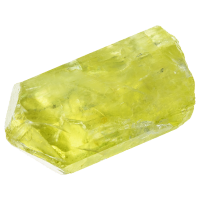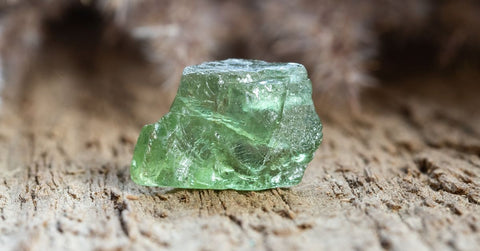Apatite Meaning, Uses, and Healing Properties

Explore the hidden apatite meaning, powerful uses, and healing properties to elevate your mental clarity and energy balance.
Apatite is a group of phosphate minerals known for its wide range of colors and uses, from jewelry to bone material in medical applications. Its healing properties are said to promote personal growth and clear negativity.
Our interest in apatite extends to its metaphysical qualities as well. It's regarded as a stone of manifestation, helping to turn ideas into reality and support spiritual growth. This crystal is also believed to connect to the Third Eye and Throat Chakras, enhancing psychic abilities and promoting the expression of truths. Whether drawn to its beauty or its reputed energy, apatite continues to be a subject of fascination and utility in various spheres.
Overview of Apatite
Apatite is a group of phosphate minerals with significant interest in various fields, from gemology to geology. It is commonly associated with calcium phosphate minerals and exhibits various physical properties that make it distinctive.
Physical Properties:
- Hardness: With a Mohs hardness of 5, apatite is moderately hard.
- Luster: The crystals typically possess a vitreous luster.
- Transparency: Apatite can be transparent or opaque.
- Crystal System: It crystallizes in the hexagonal crystal system.
Color: The colors of apatite crystals can vary, often displaying hues of green, blue, yellow, or even pink and violet. The color range is due to various impurities within the minerals.
Metaphysical Properties:
In the realm of metaphysical attributes, we find a fascinating array of beliefs associated with apatite:
- Communication: Often linked to the throat chakra, it enhances clear and calm communication.
- Creativity: Some believe apatite stimulates creativity and the intellect.
- Clarity: It is sometimes positioned as a stone that enables a deeper understanding and clarity of thought.
We understand the appeal of apatite crystals extends beyond their beauty, as many ascribe to their healing and metaphysical properties. However, our focus remains on the facts concerning their composition and varied uses. Given its calcium phosphate composition, apatite is also of interest to the scientific community, particularly in areas related to biology and Earth sciences.
Geological Significance
Our understanding of apatite's importance in geology comes from its role as the most common phosphate mineral and a significant calcium phosphate source. Found across the globe, from Brazil to Russia and Madagascar to Myanmar, apatite crystals are an integral component of igneous and metamorphic rocks as an accessory mineral.
In igneous rocks, we see apatite as a minor yet widespread accessory phase. Fluorapatite and chlorapatite are two of the mineral's notable forms, which also include hydroxyapatite, the latter being a crucial element in our own bone and tooth enamel.
Our study of apatite reveals that it is more than other minerals in the rock matrix. It is a primary source of phosphorus and, by extension, pivotal in creating the fertilizers that are a lifeline for agriculture. This has significant economic ramifications, particularly in regions with extensive apatite deposits, such as Mexico and Germany.
We note that the diversity of apatite is reflected in its array of colors—greens, blues, yellows, and occasionally purples—in various deposits around the world. The irregular presence of apatite in some rocks demonstrates its dependency on geological processes, such as magmatic differentiation or the availability of particular environmental elements.
In summary, we appreciate apatite for its aesthetic value as a gemstone and, more importantly, for its crucial role in geological processes and its significant contributions to the economic and agricultural sectors.
Physical and Chemical Properties
Apatite is a defining mineral of 5 on the Mohs scale of hardness. Its chemical composition and varied colors make it a fascinating subject of study and a helpful mineral in various applications.
Color Variations
Apatite occurs in a wide range of colors:
Blue Apatite

Blue apatite is the most sought-after color variation of this mineral. Its hues range from a vibrant teal to a soothing sea blue, often associated with clarity, communication, and spiritual guidance in metaphysical beliefs. The color of blue apatite is primarily due to the presence of copper or the substitution of elements within its crystal lattice that affect how light is absorbed and reflected.
Yellow Apatite

Yellow apatite is another beautiful variation with its bright, lemony shades. With its range of shades from pale yellow to deep gold, this color looks like the sun's warmth and power. It is usually thought that the yellow color comes from sulfur or iron in the crystal. People think that yellow apatite can boost your intelligence, creativity, and personal strength.
Purple Apatite

Purple apatite is a rare and mesmerizing color variation, displaying hues from lavender to deep violet. This color is usually the result of rare earth elements or manganese inclusions within the mineral. Purple apatite is often associated with inspiration, spiritual insight, and healing.
Green Apatite

Green apatite showcases various shades, from pale lime green to deep forest green. The green color is typically due to chromium, vanadium, or iron within the crystal structure. Green apatite is considered connected to nature, growth, and healing. It's also linked with prosperity and abundance.
Each color variation of apatite adds to the mineral's aesthetic appeal and contributes to its use in jewelry, decorative items, and metaphysical practices. The diverse palette of apatite colors is a testament to the complex interplay of geological processes that form these captivating minerals.
Composition and Formation
Chemical Formula: Ca₅(PO₄)₃(OH,F,Cl)
- Fluorapatite (Ca₅(PO₄)₃F): Contains fluorine
- Chlorapatite (Ca₅(PO₄)₃Cl): Contains chlorine
- Hydroxyapatite (Ca₅(PO₄)₃OH): Contains hydroxide
These minerals form the apatite group, primarily composed of calcium phosphate. Apatite minerals crystallize in the hexagonal crystal system and often occur as tabular, prismatic, or dipyramidal crystals.
Hardness and Durability
- Hardness: Apatite is relatively soft with a Mohs hardness of 5, meaning it has fair resistance to scratches.
- Durability: Its use in jewelry must be carefully approached due to its moderate hardness. It is suitable for items not exposed to rough wear.
The luster of apatite can vary from vitreous to subresinous, which, combined with its array of colors, contributes to its appeal as a gemstone.
Roles in Biology and Medicine
Apatite, specifically biological apatite, plays a crucial role in the composition and function of hard tissues within the human body. We recognize it as the primary inorganic constituent of bone and teeth. It provides structural integrity in bones while remaining slightly flexible due to its low crystallinity and nanometric dimensions. Our tooth enamel, the hardest substance in our body, largely derives its durability from the presence of apatite.
Teeth and Bones:
- Teeth: Apatite contributes to tooth enamel's hardness and resilience, making it resistant to decay.
- Bones: Serves as the key mineral phase, giving bones their rigidity while allowing for slight elasticity.
We also observe apatite playing a role in addressing and understanding various joint problems and conditions like arthritis. Its composition is studied extensively to develop synthetic materials that mimic the natural function of apatite in the human body. These materials are utilized in medical treatments and bone grafts.
Medical Applications:
- Orthopedics: Apatite-like materials are manufactured for bone grafts to aid in healing fractures and bone replacements.
- Dentistry: Synthetic apatite is utilized in fillings and therapeutic procedures to mimic natural teeth.
Moreover, our knowledge of apatite formation and regulation in the body can offer insights into glandular function. This understanding contributes to the broader study of mineralization in biological systems, indicating its significance beyond structural support.
Understanding and harnessing apatite's properties in medicine promotes innovation in treatment and reconstructive advancements, confirming its indispensable role in biological and medical realms.
Metaphysical Significance
Apatite, with its range of colors and forms, plays a significant role in the metaphysical realm. It is revered for enhancing communication, providing clarity, and assisting in spiritual attunement. Our exploration reveals how apatite's metaphysical properties can align with chakras, influence emotions, and contribute to spiritual attributes.
Chakra Alignment
Apatite is particularly influential in aligning the Third Eye and Throat Chakras. It is believed to stimulate the Third Eye, enhancing intuition and clairvoyance, while the Throat Chakra benefits from apatite's alleged properties that promote self-expression and communication. Individuals often use apatite during meditation to balance these chakras, essential for improving consciousness and awareness.
Emotional Influence
In emotional well-being, apatite is said to be a powerful stone that helps dissipate negativity, providing peace and reducing stress and anxiety. It also fosters harmony within relationships by helping reduce anger and irritability. The stone's calming vibrations encourage a sense of balance and confidence.
- Stress relief: Offers calming energies to reduce anxiety.
- Emotional balance: Promotes inner peace and harmony.
Spiritual Attributes
The spiritual qualities of apatite are tied to its capacity to aid in manifestation and to heighten spiritual awareness and attunement. It encourages opening the mind to knowledge and creativity, thus fostering the grounding of intentions and intellect. Apatite is also associated with enhancing focus and clarity of thought, which is believed to support deeper spiritual connection and meditation practices.
- Manifestation: Aids in realizing personal goals and desires.
- Spiritual Consciousness: Allows for higher levels of spiritual connection and exploration.
Apatite in Gemstone and Jewelry Use

Apatite is a phosphate mineral and a valued gemstone in an impressive range of colors, from teal and green to yellow and sometimes even pink or violet. The versatile hues of apatite allow it to be a gemstone with significant decorative appeal for jewelry, reminiscent of more well-known stones like tourmaline and peridot.
Characteristics:
- Colors: Teal, Yellow, Green, Pink, Violet
- Luster: Vitreous
Jewelry Considerations:
When we incorporate apatite into jewelry, we consider its relative softness and brittleness compared to other gemstones. On the Mohs scale, apatite ranks 5, requiring careful handling and setting. As a result, we recommend protective settings for apatite jewelry, such as bezels, to shield the stone from potential impacts.
Ideal Jewelry Types:
- Earrings
- Pendants
- Pins
- Tie Tacks
Given its brittleness, apatite is less suitable for rings intended for daily wear, although it can make for stunning occasional wear in a thoughtful setting. We often see apatite faceted with designs intended for harder gemstones like quartz and tourmaline because, when appropriately cut, apatite's luster and color can be reminiscent of these more durable stones.
Practical Applications
As a phosphate mineral, apatite serves several vital roles across various industries. We observe its importance primarily in the agricultural sector, where it is a key component in fertilizer production. This is due to its high calcium phosphate content, essential for plant growth.
In geology, apatite's presence in rock formations provides us with crucial data regarding the history of Earth's geological processes. Its vibrant colors and crystal structure often help us to identify and characterize the rocks it is found in. Additionally, for geologists, apatite is a tool for understanding the mineralization processes leading to the formation of ore bodies.
Here's a breakdown of apatite's practical applications:
- Agriculture: Apatite is processed into phosphate fertilizers.
- Geology: Used as an indicator mineral for geological dating.
- Dentistry: Apatite's similarity to human tooth enamel shows its use in dental products.
Apatite's utility extends into the domain of environmental remediation as well. By contributing to phosphate products that treat waste in water resources, apatite helps to reduce harmful substances and repair ecosystems.
In summary, our use of apatite ranges from nurturing crops to aiding in environmental protection and enhancing our scientific understanding of the Earth's history. Through our insights into this mineral, we tap into a resource that is as practical as it is vibrant.
Caring for Your Apatite

Apatite is not only treasured for its aesthetic appeal but also for the perceived benefits it brings. Caring for apatite ensures its physical luster and purported metaphysical properties are maintained.
Cleaning and Charging
Cleaning Apatite:
- Clean the stone gently with warm water and delicate soap.
- Never use rough things on the surface because they can scratch it.
- Dry with a soft, lint-free cloth immediately after cleaning.
Charging Apatite:
- Place the stone in natural light—either sunlight or moonlight—for several hours.
- Alternatively, you can place apatite on a selenite plate or near other crystals known for their charging properties.
Tips for Longevity
Storage:
- Keep apatite separate from other stones to prevent scratches.
- Keep them in a soft bag or a jewelry box lined with fabric.
Handling:
- Remove apatite jewelry before engaging in physical activities to prevent damage.
- Do not let harsh chemicals, extreme temps, or high humidity touch the stone.
By adhering to these practices, we can preserve our apatite pieces' beauty and structural integrity, ensuring that they last for years to come.
Final Thoughts
Apatite is a multifaceted mineral that can inspire and motivate us. Its range of colors and forms makes it an attractive choice for jewelers and collectors. This mineral can easily be mistaken for other types of stones, but its distinctive properties make it unique.
Understanding apatite's significance goes beyond aesthetics. We acknowledge its ability to foster clarity of mind, stimulate creativity, and possibly act as a motivational tool.
As with all gemstones, we advise enthusiasts to wear or use apatite while being mindful of its metaphysical attributes with a balanced perspective. While we value apatite's believed properties, it's essential to ground our appreciation in its scientific characteristics as much as its esoteric significance.
In pursuing knowledge and understanding about gemstones like apatite, we remain committed to learning and sharing our insights. This exploration of apatite meaning has examined its physical allure and the potential it holds for those who believe in its power.
Frequently Asked Questions
This section addresses common inquiries about apatite, its metaphysical attributes, and its significance in various practices and fields.
What are the metaphysical properties associated with apatite?
Apatite is believed to enhance clarity, communication, and self-expression. It is often associated with personal growth, helping to clear confusion and stimulate the intellect to expand knowledge and truth.
How can different colors of apatite, such as blue or green, affect their healing attributes?
They say that blue apatite can open the throat chakra, which makes it easier to talk to people and describe yourself. Green apatite, on the other hand, is linked to the heart chakra and helps with emotional healing and balance.
In what ways is apatite utilized in holistic or alternative healing practices?
Holistic practitioners use apatite to encourage wellness, considering it a stone that stimulates energy flow within the body, helps heal bones, and promotes new cell growth.
What significance does apatite hold in the context of spiritual or emotional well-being?
Apatite is thought to aid in the release of negative emotions, facilitating inner peace and emotional well-being. It is seen as a stone of manifestation, promoting social responsibility and service to others.
How does the presence of apatite influence the body's physical or nutritional processes?
In the context of physical health, apatite contains calcium phosphate, which is integral to bones and teeth. It is considered to have regenerative properties that can aid in healing cartilage, bones, and teeth.
What characteristics make apatite a unique choice for gemstone collectors and enthusiasts?
For collectors, apatite's wide range of colors and its potential for vivid and transparent crystals make it a notable and sought-after gemstone. Despite its brittleness, its distinctive hues and crystal forms are highly valued.
What does apatite symbolize?
Apatite is often symbolized as a stone of learning and inspiration, representing personal achievement and the quest for knowledge. It is considered to symbolize a strong motivation to achieve goals and aspirations.
What is apatite in biology?
Biologically, apatite refers to the mineral compounds, especially calcium phosphate, found in vertebrates' structural makeup of bones and teeth, playing a critical role in bodily functions and health.

